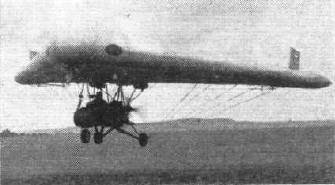Page 14 of November 2010 Lift
Aircraft Vol. 1, No.l
????
http://www.scribd.com/doc/39544462/Aircraft-Vol-3-No-1-From-www-jgokey-com
- Live-tracking of hang glider flights on the Internet
- Reefable spars for busable hang gliders ...
- Barry Hill Palmer
article coming soon.
I was Just Having Fun!
... in 1959 and
following ...
- 1909 Jane's All the World's Air-Ships, page 87.
The Danes also knew what Breslau gliding club knew, apparently; at least the
tech was fully evident, even as power was in focus.
Some funnies either way:
Paragliding Vs Hanggliding
#3
- Walter Kidde inflatable radar reflector
(not yet linked)
- "FIRST PUBLIC DISPLAY by the Army Air Corps, held at Middle
Wallop last Saturday, provided some out-of-the-ordinary flying events—and
aeroplanes. The latter included the M.L. inflatable aircraft (centre picture
below)," Click image for source:
 With power off the flying wing delta inflatable is a hung-mass glider ... yes,
mechanically simply a hang glider format device (heavy by carrying motor and
prop and pod and trike, but mechanically all there with cable-stayed airframe
truss parts, i.e. using mechanics already invented for over a hundred years.)
Flight, 1960.
With power off the flying wing delta inflatable is a hung-mass glider ... yes,
mechanically simply a hang glider format device (heavy by carrying motor and
prop and pod and trike, but mechanically all there with cable-stayed airframe
truss parts, i.e. using mechanics already invented for over a hundred years.)
Flight, 1960.
- ""Goodyear Aircraft Corp (Subsidiary of Goodyear Tire &
Rubber Corp.,
... and ten Inflatoplane inflatable aircraft, in single and two-seat models,
have been built for evaluation by the US Army and Navy."" 19 Aug.
1960, Flight, p. 249.
- Dynamic kite by Raymond P. Holland, Jr.
Patent number: 2698724
Filing date: Mar 12, 1951
Issue date: Jan 1955
-

-
http://www.thekitesociety.org.uk/WLK_Pics.htm
-
- At Simi Valley when my dad and mom were testing Bob Lovejoy's first
Quicksilver,
I was there on the ground; my dad held me while my Mom flew the Quicksilver.
I was still nursing at the time; I probably saw some some flying, but I do not
remember that moment; there is a photo of my Mom flying the Quicksilver:
http://energykitesystems.net/hgh/images/JoanneQuicksilverLnS19p10.jpg
higherwindpower higherwindpower
-
http://energykitesystems.net/images/TCFhistory/GustavLilienthalTCFmod.jpg
Source:
http://www.lilienthal-museum.de/olma/egustav.htm
-
http://www.glidingmagazine.com/FeatureArticle.asp?id=210
- http://vula2.org/
-
http://groups.yahoo.com/group/kitepatents/message/367
Open discussion on the Ulysses Grant Lee and Darrah instruction of 1910
Flying-Machine.
-

-
-
- 3153877 Filed in 1962
. Does this look familiar?
Effinger did not in his instruction recognize that the nose-piece of Wanner's
kite actually provided some equivalence to a transverse member, just as
Effinger's own Fig. 6 provided some transverse member.
Does this look familiar?
Effinger did not in his instruction recognize that the nose-piece of Wanner's
kite actually provided some equivalence to a transverse member, just as
Effinger's own Fig. 6 provided some transverse member.

Notice further interest by Effinger for his filed instruction in July
of 1963 where we note the use of term "paraglider" is not quite how we use the
term today. His dominant interest in this instruction was toward model sizes
of the wing:

July 1963 filed instruction by Effinger, Henry Struck, and Wayne Gross.
Filing date: Mar 17, 1961:

Cecil E. Craigo, Harry A. James, and Leo J. Hand instructed in 1961 and
assigned such findings to Ryan Aeronautical Co. of San Diego, California.
In their 1961 instruction:

The "G. S." is Gertrude Sudgen Rogallo; the "et. al. comprises Francis Melvin
Rogallo. The patent office and the inventors recognized that they were using
"principles described in the U. S. Patent No. 2546078" for mechanical
invention. Public media already had inked "Rogallo Revolution."
-
Peter F. Girard also instructed
Rogallo matters in a filing on August 20, 1962:

-
An enthusiast in 1962 Daniel C. Kurkjian
of Pennsylvania decided to finally file an instruction where gliding flight
unpowered was included. He cites earlier matters involving Dahl, Bach,
Stumpp, Wanner, and Rogallo, and others. Of course manned flight
in the Paresev program was starkly exceited by the leadership of Francis
Rogallo. The fever from the Sputnik response combined with hearings of
Rogallo provided a explosion of interest in the wing type that became
world-wide seen as Rogallo Wing, even though bi-lobe stiffened wings were used
for gliding in even the early 1800s; bi-wing with batten ribs with pilot hung
behind cable-stayed triangle control frame (TCF) was evident in Breslau in
1908 foot-launch hang glider within the reach of the gliding club there.
Fifty-four years later we see an enthusiast Kurkjian mentioning again what
Rogallo had demonstrated in the 1950s that these wings were mechanically
already invented for use in hang gliders, powered craft, and moored-tethered
kites. The Standard Rogallo hang glider of much later time embedded the
wing type and the Breslau TCF.



|